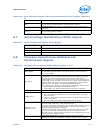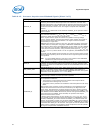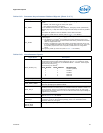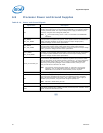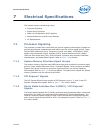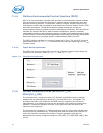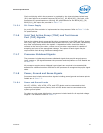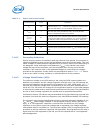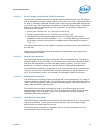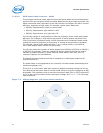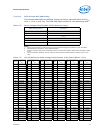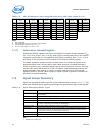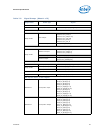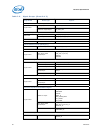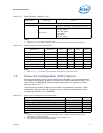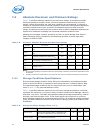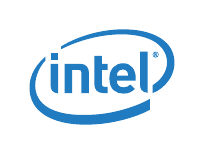
Datasheet 55
Electrical Specifications
7.1.8.3.1 Serial Voltage Identification (SVID) Commands
The processor provides the ability to operate while transitioning to a new VID setting
and its associated processor voltage rails (V
CC,
V
SA
, and V
CCD
). This is represented by a
DC shift. It should be noted that a low-to-high or high-to-low voltage state change may
result in as many VID transitions as necessary to reach the target voltage. Transitions
above the maximum specified VID are not supported. The processor supports the
following VR commands:
• SetVID_fast (20mV/μs for V
CC
, 10mV/μs for V
SA
/V
CCD
),
• SetVID_slow (5mV/μs for V
CC
, 2.5mV/μs for V
SA
/V
CCD
), and
• Slew Rate Decay (downward voltage only and it is a function of the output
capacitance time constant) commands.
Table 7-3 includes SVID step sizes and DC
shift ranges. Minimum and maximum voltages must be maintained as shown in
Table 7-10.
The VRM or EVRD used must be capable of regulating its output to the value defined by
the new VID.
Power source characteristics must be ensured to be stable when the supply to the
voltage regulator is stable.
7.1.8.3.2 SetVID Fast Command
The SetVID-fast command contains the target VID in the payload byte. The range of
voltage is defined in the VID table. The VR should ramp to the new VID setting with a
fast slew rate as defined in the slew rate data register; typically, 10 to 20 mV/μs
depending on platform, voltage rail, and the amount of decoupling capacitance.
The SetVID-fast command is preemptive; the VR interrupts its current processes and
moves to the new VID. The SetVID-fast command operates on one VR address at a
time. This command is used in the processor for package C6 fast exit and entry.
7.1.8.3.3 SetVID Slow Command
The SetVID-slow command contains the target VID in the payload byte. The range of
voltage is defined in the VID table. The VR should ramp to the new VID setting with a
“slow” slew rate as defined in the slow slew rate data register. The SetVID_Slow is 1/4
slower than the SetVID_fast slew rate.
The SetVID-slow command is preemptive; that is, the VR interrupts its current
processes and moves to the new VID. This is the instruction used for normal P-state
voltage change. This command is used in the processor for the Intel Enhanced
SpeedStep Technology transitions.
7.1.8.3.4 SetVID Decay Command
The SetVID-Decay command is the slowest of the DVID transitions. It is only used for
VID down transitions. The VR does not control the slew rate; the output voltage
declines with the output load current only.
The SetVID-Decay command is preemptive; that is, the VR interrupts its current
processes and moves to the new VID.



